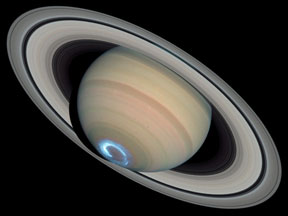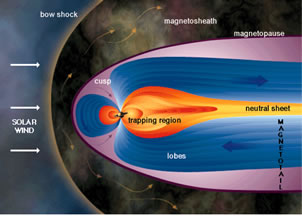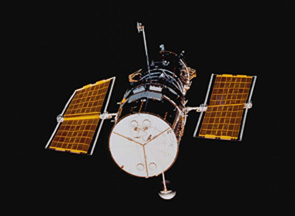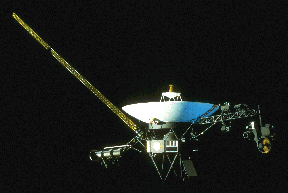Click on image for full size
Image courtesy of NASA, ESA, J. Clarke (Boston University), and Z. Levay (STScI).
Saturn's Aurora
Have you ever seen the Southern or Northern Lights? Earth isn't the only planet that puts on these beautiful light shows, which are also called the "aurora". Aurora have been seen at both poles of Saturn, too.
The solar wind is a flow of charged particles that stream outwards from the Sun. When they get to Saturn, some of those particles are trapped by Saturn's magnetic field. Fast-moving electrons bounce back and forth in Saturn's magnetic field, gaining more and more energy. Some of them blast into Saturn's atmosphere near the planet's poles. The electrons cause hydrogen gas in the atmosphere to glow. It is a lot like the glow that lights a fluorescent bulb when electricity flows through it.
Aurora on Earth usually shine for a few hours at most. Aurora on Saturn can last for days! These "curtains of light" sometimes rise 1,200 miles (2,000 km) above the cloud tops near Saturn's poles. If you were on Saturn, the aurora would look like a faint red glow. Most of the energy in Saturn's aurora is not in the form of visible light, though. Instead, they mostly glow in ultraviolet (UV) wavelengths.
Most UV "light" cannot get through Earth's atmosphere. That means telescopes on the ground cannot see Saturn's UV aurora. However, telescopes in Earth orbit can. Spacecraft that fly near Saturn can also "see" the ringed planet's aurora. The Hubble Space Telescope has taken some pictures of Saturn's aurora. The Pioneer 11, Voyager 1 & 2, and Cassini spacecraft have observed Saturn's aurora from closer range.
The aurora at Earth are mostly caused when high-energy particles collide with either nitrogen or oxygen in our atmosphere. Saturn's aurora are caused by electrons crashing into hydrogen molecules and atoms in Saturn's upper atmosphere. Scientists have also detected radio signals emitted by Saturn's aurora. It is a lot like the static you can sometimes hear on a radio when lightning strikes nearby.














